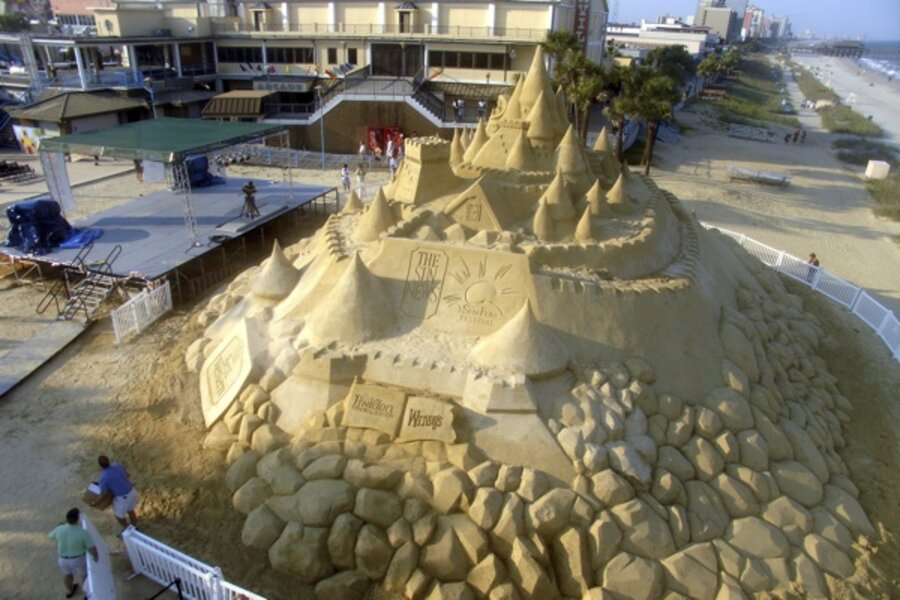Is the Fed building sandcastles?
Loading...
Chairman Ben Bernanke says don’t blame the Fed for rapidly increasing commodity prices and probable bubbles forming in many investment markets throughout the world. I am just doing what is necessary for a recovery in the US and that is in the interests of the world. (See “Bernanke Defends US Policies” Wall Street Journal, February 19-20).
The reality is different. From a short-run point of view there is no reason for Bernanke to care what is going on in other nations. He will be judged “by history” by what happens here in the US. Therefore, he cannot be trusted to take the costs of policy – elsewhere in the world – fully into account. However, since bursting bubbles will affect asset markets here, he may begin to worry later.
And yet our fellow is boxed in. As he creates more money, and keeps interest rates low, in an effort to spur spending, much of the money will chase higher, riskier yields in foreign markets. From a US perspective, damage to foreign markets may just be the price we – oops they – have to pay.
But is the US successfully shifting the costs of its monetary policy to foreign countries? The prevailing view at the Fed and elsewhere seems to be as long as “inflation” is under control then the appropriate policy is further stimulus through quantitative easing. But wait a minute. The last two recessions – including the so-called Great Recession – were not preceded by bouts of inflation. Obviously, then, bad things can happen without general inflation.
Bernanke realizes that overall measured inflation is not increasing (as much as he thinks bad, that is) because (1) the prices of services are relatively stable and (2) food and other commodity-dependent prices are excluded, by definition, from core inflation.
On the first point, I should think that service prices – closer in general to the consumer stage – would not be as affected by low interest rates as those sectors farther from consumption. Certainly, at the early stages of massive credit expansion with low interest rates this is the case. On the second point, there is a sensible case to be made for excluding food and fuel if they are simply being “normally” volatile – that is, experiencing ups and downs due to weather or other temporary factors. (Let us put aside for the moment commodity price appreciation due to political unrest in the Middle East. The rise in commodity prices predates this.)
But we have other plausible explanations. Commodity prices are a frequent indicator of inflationary fears. They are also, because of their volatility, a good vehicle for speculative demands – money in search of higher returns. Furthermore, to the extent that other economies are over-heating, in part due to US policy, their demands for commodities of all kinds will increase. These demands are not sustainable – which is the point.
Closer to home, the stock market (S&P) has now experienced the fastest rise ever in the past two years, just about doubling. Is that because the Fed has made everything all better now and we are almost back we started from? Or are we witnessing the curious combination of firms being cautious about real investment and financial investors seeking yield? Money created out of thin air needs to find a home.
(Of course, the averages are helped a lot by bank stocks doing well as a result of the infusion of TARP money. But that has covered up the real negative value of the banking sector and built expectations of further rescues when behavior is not sustainable.)
A non-sustainable stock market rise based on expectations of bailouts if bubbles burst is a fine recipe for future difficulties.
I do not pretend to have definitive answers but there is certain complacency emanating from Bernanke that is not warranted either by his personal record at the Fed or by the facts. I know people will say that he must project self-confidence for the sake of the markets. I am not of big fan of purely atmospheric confidence, that is, of thinly-based confidence.
I fear we are living in a precarious world with the Fed building sand castles. But at least Bernanke has his self-confidence.
Add/view comments on this post.
--------------------------
The Christian Science Monitor has assembled a diverse group of the best economy-related bloggers out there. Our guest bloggers are not employed or directed by the Monitor and the views expressed are the bloggers' own, as is responsibility for the content of their blogs. To contact us about a blogger, click here. To add or view a comment on a guest blog, please go to the blogger's own site by clicking on the link above.





